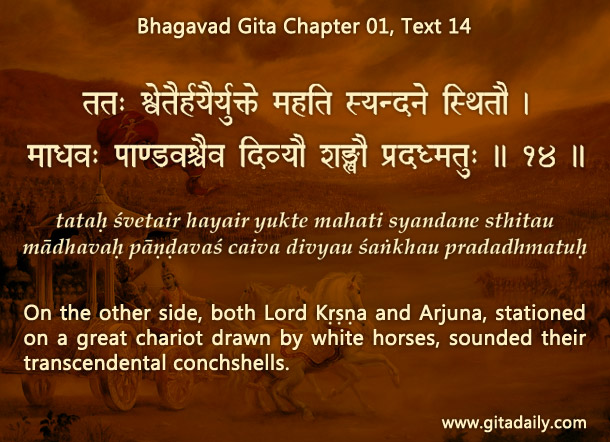The Bhagavad-gita is often seen as a philosophical treatise that contains many profound truths. While the Gita is certainly philosophical, it is simultaneously conversational. And its two conversants are not just literary tools for presenting its philosophy — they are the heart of the Gita’s message. Let’s see how.
In the Gita, wisdom is shared by Krishna, who is the supreme divinity descended on earth to help raise human consciousness. And wisdom is sought by Arjuna, who is the quintessential human being embodying a galaxy of virtues ranging from asceticism to heroism. Krishna and Arjuna are intimate friends whose relationship goes a long way back, as is described in the Mahabharata. The Gita spotlights them in its first chapter while describing how they are together on a magnificent chariot on the Kurukshetra battlefield (01.14).
It is love that inspires Krishna to speak the Gita’s message. He wants to help his dear friend navigate an agonizing dilemma: what to do when different duties pull in opposite directions. In addressing this dilemma, Krishna preserves a unifying thread of love throughout the Gita. How?
- By regularly using terms of endearment.
- By highlighting love in the Gita’s concluding crescendo (18.65-66): declaring his love for Arjuna and movingly calling for Arjuna’s reciprocal love.
- Most importantly, by using the Gita’s philosophical deliberations to establish how life’s worst perplexities can be tackled by acting with love: love for the Divine and love for everyone as parts of the Divine.
Thus, we can re-envision the Gita as a loving discussion that philosophically explores the primacy of love. Such an approach to Gita study won’t just energize our head; it will also enrich our heart.
One-sentence summary:
The Gita is not just a book of philosophy; it is a discussion between divinity and humanity whose philosophical deliberations reveal how love can be our guiding light in all situations.
Think it over:
- What is the role of the two conversants in the Gita?
- How is the Gita seen frequently? How can it be seen more holistically?
- By seeing the Gita as a love-centered philosophical discussion, we can relish it much more. Explain.
***
01.14: On the other side, both Lord Krishna and Arjuna, stationed on a great chariot drawn by white horses, sounded their transcendental conchshells.
To know more about this verse, please click on the image


Hare Krishna….. this is a wonderful text, thank You prabhu ji… and the verse … wow!!! It is amazing!
Thanks for the comment.
Thank you for pointing out how Gita is not merely a philosophical conversation – its a conversation born out of loving concern, and impregnated with that sentiment throughout its flow.
Seen in this light, Krishna’s words in 18.68-69: “one who explains this supreme secret to the devotees… There is no servant in this world more dear to Me than he…” make a lot of sense. Krishna has special affection for His devotees. If a person can help a devotee overcome a difficult circumstance by sharing the Gita wisdom, then such a person would naturally become very dear to Krishna.
Good correlation – thanks.
Hare Krishna Prabhuji, Dandawat Pranam..
To the best of my understanding following realisation I have –
1. When we say that it is conversation then, that can be very peaceful, understandable and free of envious and jealousy when that is between the person who lovingly recognise not only each other but themselves also. This will bring the persons to the platform of conversation.
2. When the persons in conversation are in the above mood then the result of conversation will be holistic. And that conversation will be lovingly shared among the persons at large and will be understood by persons who are also in the moods of conversants.
Hare Krishna.
Well-said; thanks.